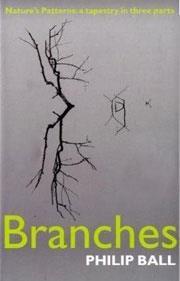Branches
Branches
Philip Ball
Oxford, UK: Oxford University Press 2009 | 221pp | ?14.99 (HB)
ISBN 9780199237982
Reviewed by Hamish Kidd
This is the last in the three-book series by Philip Ball on nature’s patterns, following Shapes (ISBN 9870199237968) and Flow (ISBN 9780199237975).

Trees are the most common examples of branching patterns - the term dendritic is from the Greek word for a tree - but Ball describes how similar patterns occur in coastlines, river networks, crack patterns etc as a result of the interplay of common physical and chemical forces. Finally the book explores how networks and webs abound in nature and in our man-made world of communications.
Although not discussed in detail within this book, tree-like structures inspired chemists like Donald Tomalia and Jean Fr?chet to synthesise repeatedly branched ’dendrimer’ molecules (see Chemistry World, May 2007, p62).
The common mathematical principles of fractals, chaos and connectivity behind these processes are discussed in an easily understandable way, so that the book can been enjoyed by a general readership.












No comments yet